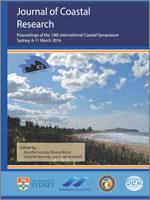Stephenson, W.J. and Abazović, A. 2016. Measuring Coastal Boulder Movement Under Waves Using Tri-Axial Accelerometers. In: Vila-Concejo, A.; Bruce, E.; Kennedy, D.M., and McCarroll, R.J. (eds.), Proceedings of the 14th International Coastal Symposium (Sydney, Australia). Journal of Coastal Research, Special Issue, No. 75, pp. 607–611. Coconut Creek (Florida), ISSN 0749-0208.
Boulder entrainment under tsunami or storm wave conditions has been a topic of interest among coastal geomorphologists for the last 25 years. Efforts have been directed to understanding the dynamic conditions under which boulder entrainment occurs and in particular the energy levels required to move boulders of specific sizes. Recent focus on storm waves has highlighted the complexity of the process and that more energetic tsunami waves are not always needed to move larger boulders. Consequently attempts have been made to develop better empirical equations to predict wave height or flow velocity and differentiate between storm waves and tsunami. However, data collection methods are restricted to hindcasting flow conditions based on boulder size, the chosen empirical equations and assumptions regarding historical storm or tsunami events. Significant advances could be made using real time entrainment data of boulder movement alongside flow conditions. This is particularly true if movement type, e.g. suspension, rolling or sliding can be distinguished. This paper demonstrates the use of small and inexpensive tri-axial accelerometers manufactured by Gulf Coast Data Concepts. The accelerometers were placed in PVC water tight housing then located in holes cored into boulders and deployed in conjunction with wave pressure transducers on the shore platform. Movement of 4 boulders were observed by logging real-time accelerations during a 5 day deployment. Preliminary data demonstrated that boulders rolled and moved up to 3 m in a westerly direction, while wave heights were less than 0.7 m, demonstrating of the viability of this technique.





